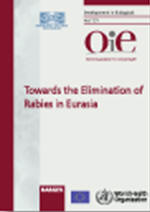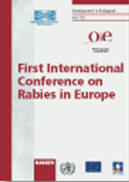Further reading
Towards
the Elimination of Rabies in Eurasia
|
Joint OIE/WHO/EU International Conference,
Paris, May 2007: Proceedings |
|

|
Editor(s): Dodet, B. (Lyon);
Fooks, A.R. (Weybridge); Müller, T. (Wusterhausen/Dosse); Tordo, N. (Paris);
Society/ies: International Association for Biologicals,
Developments in Biologicals,
Vol. 131
ISBN 978-3-8055-8550-7 |
This
volume presents the proceedings of the second conference on rabies organized by
the World Organisation for Animal Health in collaboration with the World Health
Organization and the European Union in May 2007. Up-to-date information on
rabies epidemiology in humans and animals throughout Europe, The Middle East and
Asia, and the most recent data on rabies virus and its structure, as well as the
basic mechanisms of rabies infection are included here. Experts in the field
present their experience and opinions on the prevention and control of rabies in
dogs, wildlife including bats, and the most recent developments in rabies
prevention and management in humans. Further presentations address advances in
technology, diagnosis and vaccine development. To conclude, resolutions and
recommendations are given in English, French and Russian for the elimination of
rabies not only in Europe and Asia, but also the rest of the world.
This book is highly valuable to regulatory veterinary services, public health
services, medical and veterinary practitioners, scientists and researchers
interested in combating this neglected disease, which kills more than 50,000
persons annually, mainly children. Rabies elimination is at hand, through a ‘One
Health’ strategic collaboration between veterinary and human health authorities,
political will and community involvement, and application of the knowledge
gained from this volume.
Rabies in Europe
|
1st International conference, Kiev, June
2005: Proceedings |
 |
Editor(s): Dodet, B. (Lyon);
Schudel, A. (Paris); Pastoret, P.-P. (Fontin); Lombard, M. (Lyon)
Society/ies: International Association for Biologicals,
Developments in Biologicals,
Vol. 125
ISSN 1424-6074 |
Presents the latest research in rabies prevention and control
Rabies is still one of the most feared diseases in the world and its control
remains a key objective in large parts of Europe. This major meeting brought
together veterinarians, scientists, clinicians and public health officials
to share their experience in rabies control, to examine the threat posed by
the common rabies virus and emerging strains, and to develop strategies for
the prevention, control and eradication of rabies in Europe.
Rabies in Europe reveals the true epidemiological situation of an often
overlooked menace and presents the latest research by over 40 prominent
scientists in rabies prevention and control. It proposes practical solutions
and includes the official WHO/OIE recommendations issuing from the meeting.
The book provides researchers, healthcare professionals and public health
officials with an up-to-date, in-depth look at the threat still posed by
rabies and shows how medical and scientific advances have been employed to
stem the growing number of infections spreading from Eastern to Western
Europe since the end of World War II.
Historical
Perspective of Rabies in Europe and the Mediterranean Basin
 |
by A.A. King, A.R. Fooks, M. Aubert and
A.I. Wandeler, eds
ISBN 92-9044-639-0 |
The importation of animals and their products
involves a degree of disease risk to the importing country, represented by one
or several diseases or pathogenic agents.
Throughout the 20th Century, control
strategies for rabies in Europe have significantly reduced the human burden of
disease. Rabies has been successfully eradicated from many European countries
and in this book leading experts describe the various approaches that have been
taken. This comprehensive historical review aims to provide scientists,
veterinarians and policy-makers with a historical account and expert analysis of
rabies from ancient times to today. Readers will benefit from several expertly
drafted articles brought together in a single volume. Each chapter is clear and
concise and focuses on a different region in Europe, North Africa and the Middle
East. The book includes country-specific rabies reports from the United Kingdom,
Ireland, Iceland, Norway, Sweden, Finland, Estonia, Latvia, Lithuania, the
European parts of Russia, Belarus and Ukraine, Poland, the Czech Republic, the
Slovak Republic, Germany, Denmark, Austria, Hungary, Italy, Croatia, Bosnia,
Slovenia, Macedonia, Albania, Greece, France, the Netherlands, Belgium,
Luxembourg, Switzerland, the Iberian Peninsula, Turkey, Cyprus, Syria, Lebanon,
Israel, Jordan, Algeria, Egypt, Libya, Malta, Tunisia and Morocco. Additional
chapters describe rabies in the ancient world and the history of dog rabies in
the Mediterranean Basin, and other chapters cover the different epidemiological
models of rabies, such as the epidemiology and ecology of fox rabies in Europe;
a description of the computer analysis of fox-rabies epidemics is also included.
Rabies virus variants and the molecular epidemiology of the disease in Europe
are discussed in chapters describing Lyssavirus infections in European bats and
Europe as a source of rabies for the rest of the world. Following the first
description of rabies from ancient scriptures the animal/human relationship is
explored further through chapters entitled ‘Folklore, perceptions, science and
rabies prevention and control’, ‘Human rabies and its prevention’ and ‘European
rabies control and its history’. Finally, the role of international
organisations, such as the World Organisation for Animal Health (OIE), the World
Health Organization (WHO) and the European Union (EU), is discussed in a chapter
entitled ‘International co-operation and the role of international organisations’.
This book is essential reading for anyone involved in disease control policies
and especially those involved in the control of rabies.